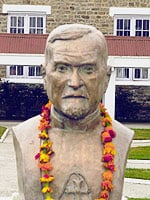In 1823, John William Ricketts, an Anglo-Indian leader from Calcutta, conceived the idea of a school to meet the educational needs of the growing British and Anglo-Indian community in Calcutta. At 7:00 AM on (Thursday) May 1, 1823, the Parental Academic Institution was established and started functioning on 11, Park Street between the Archbishop House and thethen Sans Souci Theatre with an amount of then Rs 3551.The first Principal of the institution was Dr George Smith.

In 1847, the school was renamed St. Paul’s School by Bishop Wilson, who had associated the school with St. Paul’s Cathedral in Calcutta. During 1863, the school was in difficulties and Bishop Cotton decided to move the school to Darjeeling. The current buildings were not the location of the initial school and were later additions as the school expanded.In 1864, the school was moved to its present Jalapahar (“Burning Mountain”) estate in Darjeeling with 31 boarders and a few day scholars. The estate was purchased from Mr BrianHodgson for Rs.45,000. The original two-storied building, built on what is today known as the Lower Field, no longer exists, and the magnificent buildings that form the core of the school were largely built in 1898. The first electricity lines in the school were connected in 1909. The Lefroy Hospital was commissioned in 1914 and the Lyon Hall in 1915 respectively.In 1920, the chapel was demolished to make room for Westcott Hall, thanks to a liberal donation from the Maharaja of Burdwan. Construction for the existing school chapel began in 1933 and was completed in 1935.

The Rectory in St. Paul’s School, Darjeeling houses the Rector of the school and his family. The Rectory is one of the oldest buildings in Darjeeling hailing from the British-Indian Era. Built in 1813, it was the residence of the owner of the Jalapahar estate till 1864. In 1864 Bishop G. E. L. Cotton acquired the Jalapahar Estate for establishing the School and this building was christened the ‘Rectory’ which remains, till today, the official residence of the Rector.’Pelly’s’ is the residential building which houses the official residence of the Senior Master of St. Paul’s School and his family. The building is named after a former Rectorof the School, Rev. R. L. Pelly.A number of its students fought in both World War I and World War II. Many of those who died are remembered in plaques that can be found in the school chapel.Bishop Foss Westcott, Metropolitan of Bengal, Burma and Ceylon, played a very important role in the school. L. J. Goddard, was the longest serving and, perhaps, the most important Rector,leading the school between 1934 and 1964 — including the transition from British-ruled to independent India. His successors were David Gibbs (1964–72) and Hari Dang (1977–84). L.J.Goddard and David Gibbs received the OBE.Goddard for his contribution to Education in India and his work at St Pauls and Gibbs for his work at St. Paul’s, while Dang received the Padma Shri.Over the years, a number of estates were purchased and merged with the existing school estate, thus growing to its present size. The Mount Vernon Estate (now known as Dawkins) was purchased at the beginning of the 1900s and the Terpsithea Estate in 1955.[1] The school was under the guidance of Mr. Gardner from 1984-1990. Today, St.Paul’s is home to Indian and international students from neighboring Sub-continental, South-East Asian and European countries.
